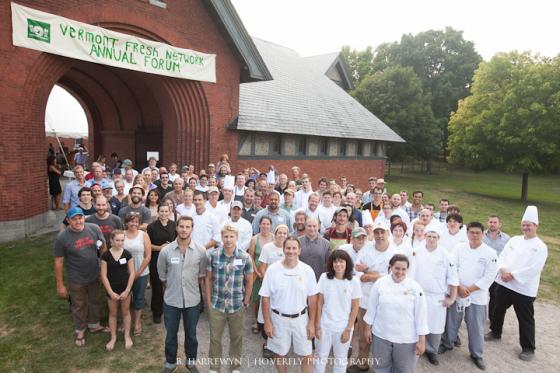Posted March 17, 2022 at 10:36am by Anonymous (not verified)
Vermont Fresh Network

Chefs and farmers couldn’t have more opposite schedules. Chefs work primarily in the late afternoon and well into the evening. Farmers are early risers, falling into bed soon after summer poultry are locked in for the evening.
The fact that chefs and farmers are like ships passing in the night is one reason why the Vermont Fresh Network has been invaluable in fostering chef-farmer relationships in Vermont. The organization, whose mission is to increase the amount of local food bought and served by Vermont restaurants, does this, in part, by posting chef and farmer profiles on its website. If a new restaurant wants, say, a source of local lamb, or a local farm wants to sell its lamb to a restaurant, the two can find each other.
Think of it as a matchmaking service for chefs and farmers – except VFN encourages the matchmaking to happen in person.
“When I first started, I was marrying people in my mind, figuring out that this farmer would work well with that chef,” says Meghan Sheradin, executive director of VFN since 2005. “But that didn’t necessarily work. What worked were face-to-face events where they actually met and took the relationship from there.”
This is why VFN hosts a number of events, such as its Annual Forum, annual meeting, and a dinner series. These events help foster the trust that is necessary for a chef-farmer partnership to thrive. Why trust? “Both partners constantly need to be flexible,” Sheradin says, because of the perpetual risk that Mother Nature poses to on-time delivery by farmers.
In 2012, VFN’s member chefs purchased $9.2 million worth of Vermont grown and raised food. Not all of that was delivered directly to restaurants by farmers, though. Distributors, such as Upper Valley Produce and Black River Produce, were recognized by VFN several years ago as key links in the farm-to-restaurant chain, and a number of them are now VFN members.
To become a member, chefs must purchase food from at least four VFN farmers, producers or processors; ensure that at least 15% of their food is Vermont grown or produced; feature a menu that contains Vermont products which represent three of the six USDA food groups; and attend at least one VFN networking event. A VFN farmer must have at least one purchasing agreement with a VFN-member restaurant.
Because a number of VFN chefs have been purchasing local food for many years, the organization is coming up with new ways to keep membership relevant. In 2013, VFN will start to host field trips, taking chefs to places such as Portland, Maine, and Providence, Rhode Island, to learn about successful farm-restaurant partnerships there. VFN will also start publicly recognizing Vermont chefs who buy from 15 or more farms and spend 30% of their yearly purchases (or $175,000 annually) on local food.
Having launched in 1995, VFN was an early pioneer in raising local food awareness among Vermont diners and tourists. It does so primarily through its Annual Forum, a summer dinner celebration open to all, its “Pocket Guide to Dining Locally,” and its familiar fork-and-knife signs, which hang in VFN restaurants to tell customers that local food is served there.
After all, says Sheradin, “The backbone of our organization is people knowing each other,” and first you have to know whether a person’s heart – and their business plan – is committed to local food.
Written by Caroline Abels
